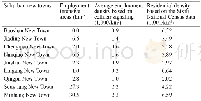《Table 1 Employment density and residential density in suburban new towns》
 提示:宽带有限、当前游客访问压缩模式
提示:宽带有限、当前游客访问压缩模式
本系列图表出处文件名:随高清版一同展现
《Development of Suburban New Towns in Shanghai: Jobs-Housing Spatial Relationship Analysis》
Note:The average employment density in the table can be only compared among new towns because the sample has not been expanded.
Using Getis-Ord Gi*statistic for local spatial autocorrelation,this paper identifies employment-intensive areas.It takes the high clustering area with a significance level of 5%as a job gathering area,of which the high clustering area larger than 1 km2 is regarded as an employment-intensive area in Shanghai.Seeing from the spatial distribution of employment-intensive areas(see Figure 2),the largest employment-intensive area is located in the central city,together with 26 ones outside the central city,most of which are in new towns.In fact,except for Baoshan New Town,all other new towns have employment-intensive areas.Outside new towns,there are only nine employment-intensive areas located in Huinan Town in Pudong New Area and Haiwan University Town in Fengxian District.This shows that new towns are already major areas for economic activities in the suburbs of Shanghai.In terms of the employment-intensive area in each new town(see Table 1),Minhang New Town and Songjiang New Town have largest ones,30.5 km2and 27.3 km2 respectively,followed by Nanqiao New Town and Jiading New Town,with 6.5 km2,showing that these new towns have higher employment density due to more job positions.
| 图表编号 | XD0012618600 严禁用于非法目的 |
|---|---|
| 绘制时间 | 2018.03.01 |
| 作者 | Niu Xinyi、Ding Liang、Song Xiaodong、Li Min |
| 绘制单位 | College of Architecture and Urban Planning, Tongji University,Key Laboratory of Ecology and Energy-Saving Study of Dense Habitat (Tongji University), Ministry of Education@Li Min |
| 更多格式 | 高清、无水印(增值服务) |
查看“Table 1 Employment density and residential density in suburban new towns”的人还看了
-

- Table 1 Relationship between population density, economic density and the corresponding land use type indices





